Zoom
Trash

Addressing Implicit Bias. Image from Manascan (2020) I must say that I have learned more about equity, diversity, bias, and inclusivity in the past year than I have during my entire adult education.
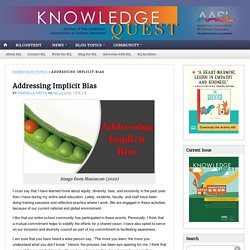
Lately, students, faculty, and staff have been doing training sessions and reflective practice where I work. We are engaged in these activities because of our current national and global environment. I like that our entire school community has participated in these events. Personally, I think that a mutual commitment helps to solidify the efforts for a shared vision. I am sure that you have heard a wise person say, “The more you learn, the more you understand what you don’t know.” I have been learning how to express myself and ask questions, not just regular questions, but difficult questions about diversity and inclusion. Suspending judgment has led me to my current reading materials. Tales from a Loud Librarian. Reading Across a Dozen Literacies. This article will define each literacy while giving examples of "reading" within each category.
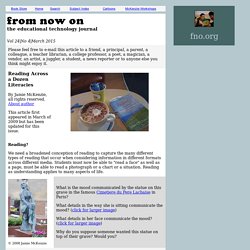
It takes special skills to read a swamp or a beach or a desert area. These skills also differ from region to region as the flora and fauna shift. Most of us have heard of swimmers caught in rip tides because they did not know how to read the signs or of visitors enjoying tidal flats suddenly swept up in an incoming tide much larger than anything they knew back home. Artistic Literacy Anyone can look at a painting, a photograph or a movie. But looking, commenting, listening or sitting do not automatically translate into understanding. One can learn to read a photograph - understand its elements and interpret its meanings. Apply your own interpretive skills to this photograph by Rosie Hardy, Seven Deadly Sins, Pride : What choices did this photographer make in setting up the image? Students will observe and make personal decisions about abstract artworks using a four-step critique process: 1. 2. 3. Home - Doug Johnson's Blue Skunk Blog.
Teen Librarian Toolbox — @TLT16 Pprofessional development for teen librarians. Home. Collaborative Computing vs One to One. This is a guest post from Tracy Dabbs, Coordinator of Technology and Innovation for the Burlington-Edison School District.
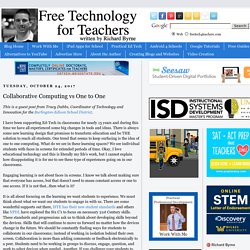
I have been supporting Ed-Tech in classrooms for nearly 15 years and during this time we have all experienced some big changes in tools and ideas. There is always some new learning design that promises to transform education and be THE solution to reach all students. One trend that seems to keep surfacing is the idea of one to one computing. What do we see in these learning spaces? We see individual students with faces in screens for extended periods of time. Engaging learning is not about faces in screens. It is all about focusing on the learning we want students to experience. Three Good Places to Find Public Domain Images.
School Library Collection Development. Resources for School Librarians - Index "It does not matter how many books you may have, but whether they are good or not.
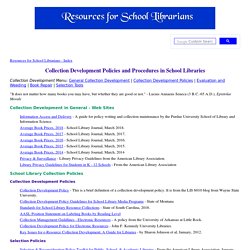
" - Lucius Annaeus Seneca (3 B.C.-65 A.D.), Epistolae Morale Collection Development in General - Web Sites Information Access and Delivery - A guide for policy writing and collection maintenance by the Purdue University School of Library and Information Science. Average Book Prices, 2018 - School Library Journal, March 2018.Average Book Prices, 2017 - School Library Journal, March, 2017. Average Book Prices, 2016 - School Library Journal, March, 2016. The School Library Media Specialist: Information Access & Delivery. The teacher librarian sustains a healthy collection through an effective maintenance program.
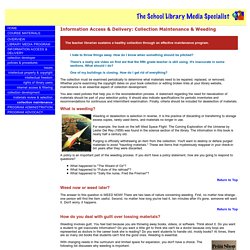
I hate to throw things away. How do I know when something should be pitched? There's a really old video on first aid that the fifth grade teacher is still using. It's inaccurate in some sections. What should I do? The collection must be examined periodically to determine what materials need to be repaired, replaced, or removed. You also need policies that help you in the reconsideration process. The School Library Media Specialist: Library Media Program: Introduction. What is collection mapping?
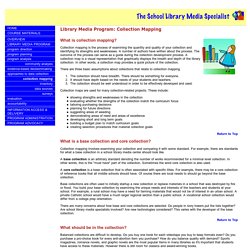
Collection mapping is the process of examining the quantity and quality of your collection and identifying its strengths and weaknesses. A number of authors have written about the process. The outcome of the process can serve as a guide during the collection development process. A Media Specialist's Guide to the Internet. Kristin Fontichiaro's Blog About Learning, Teaching, Making Things, and Libraries. Building professional capacityTeacher-librarians are well positioned to impart data literacy to teens, but who’s giving instructors the resources and support that they need to do so?
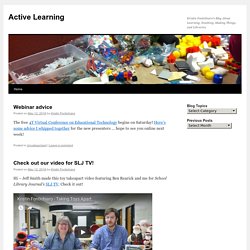
Kristin Fontichiaro, clinical associate professor at University of Michigan’s School of Information, and Jo Angela Oehrli, learning librarian at University of Michigan Library, were up for the task. As principal investigators of the two-year IMLS-funded project “Supporting Librarians in Adding Data Literacy Skills to Information Literacy Instruction,” they set out to design materials for high school librarians looking to foster data and statistical literacy skills in their students. “We were seeing on our own campus that data was becoming a powerful mode of expression and wasn’t working in ways that information literacy always works,” says Fontichiaro.
Doug Johnson's Blue Skunk Blog. Information Literacy Process. Technology, libraries, and schools. Reading Across a Dozen Literacies. The Unquiet Librarian. NeverEndingSearch — @joycevalenza by Joyce Valenza. Annoyed Librarian — Whatever It Is, I'm Against It. Librarian in Black – Sarah Houghton. Putting the rarin back in librarian since 1999. Loertscher: School Libraries. Informania. Violet H. Harada. Bibliotech.me. Kathy Schrock's Kaffeeklatsch.